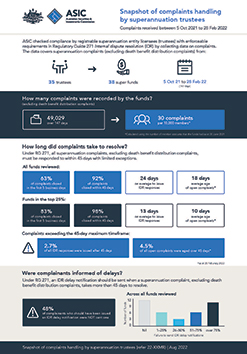Superannuation trustees are being urged to review their internal dispute resolution (IDR) arrangements after the first stage of an ASIC surveillance found indicators of significant compliance issues.
ASIC’s surveillance examines trustees’ compliance with the new enforceable requirements in Regulatory Guide 271 Internal dispute resolution (RG 271), which took effect on 5 October 2021. It follows ASIC’s earlier survey of trustees’ preparedness for compliance with RG 271, which highlighted focus areas for trustees before the new requirements commenced (refer 21-230MR).
For the first stage of the surveillance, ASIC gathered and analysed data on the status and timeliness of complaints handling (excluding objections to death benefit distributions) from a selection of 35 trustees of 38 funds covering 49,029 complaints received between 5 October 2021 and 28 February 2022.
‘Dispute resolution is an essential part of the consumer protection framework in Australia,’ ASIC Commissioner Danielle Press said. ‘A trustee’s approach to dispute resolution is a meaningful measure of whether they are focused on the interests of their members. It also indicates the maturity of the trustee’s approach to risk. When done well, dispute resolution can benefit trustees by helping build members’ trust and confidence.
‘However, the first stage of ASIC's surveillance about internal dispute resolution practices of trustees has identified some problem areas that need fixing. We want trustees that have fallen behind to strengthen their internal dispute resolution arrangements to make sure that member complaints are handled in an effective, fair and timely way,’ Ms Press said.
Observations based on data collected
- Recording of complaints: RG 271 requires trustees to record all member complaints. Overall, funds recorded complaints at a rate of 30 for every 10,000 members (calculated using the number of member accounts that the funds had as at 30 June 2021). However, 10% of the funds that ASIC looked at recorded less than 10 complaints for every 10,000 members. This is significantly lower than the overall rate. ASIC is concerned that the low complaint rate may be a result of some trustees failing to record all member complaints or adopting an inappropriately narrow definition of ‘complaint’
- Response timeframes: Across the 38 funds reviewed, 2.7% of the total IDR responses were sent after the 45-day maximum timeframe generally required under RG 271. Of these, seven funds sent out 10% or more of their IDR responses after 45 days. ASIC is concerned that trustees may be over-applying the limited exceptions to the maximum timeframe or not sufficiently monitoring how long complaints take to resolve.
- Informing complainants of delays: RG 271 requires trustees to notify complainants of delays and their right to go to the Australian Financial Complaints Authority when a written response to a complaint is not sent within 45 days. However, ASIC’s review found that in such circumstances, complainants were not notified nearly 50% of the time.
- Process failures: One in three trustees advised ASIC that there were varying degrees of process failures or errors in their IDR systems. These included identifying or capturing complaints correctly, omitting mandatory content from IDR response letters or failing to send out IDR responses for some complaints.
Commissioner Press said, ‘ASIC warned trustees that they needed to prepare for compliance with the enforceable requirements in RG 271. We expect all trustees to have in place effective arrangements that support expressions of dissatisfaction from their members and deliver fair, transparent and timely member outcomes. Trustees should continually monitor and update their processes to ensure these remain fit-for-purpose’.
In the next stage of the surveillance, ASIC will check how relevant trustees among those reviewed, are addressing the concerns identified so far and closely examine a smaller sub-set of trustees. ASIC will also consider regulatory action where appropriate, and intends to communicate the outcomes once the surveillance is complete.
Background
For this review, ASIC chose 35 trustees of funds with more than 50,000 member accounts, and predominantly with over $10 billion in assets. ASIC excluded trustees likely to go through significant change in the short to medium term, such as a change of control or merger.
According to APRA, as at 30 June 2021, the 38 funds in ASIC’s review covered industry, retail, public sector and corporate funds, managing approximately 16.5 million member accounts and over $1.5 trillion in assets.
RG 271 explains what financial firms must do to have an internal dispute resolution system that meets ASIC’s standards and requirements. Certain provisions in RG 271 were made enforceable by way of ASIC Corporations, Credit and Superannuation (Internal Dispute Resolution) Instrument 2020/98. Superannuation trustees also need to comply with s101 of the SIS Act in relation to IDR.
